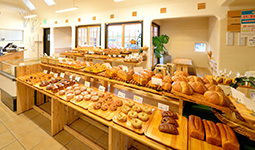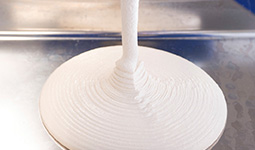INDEX
- English
- 日本語

A selection of brown rice breads sold at GENKI-DO - English
- 日本語

Three varieties of brown rice bread that are completely gluten-free and also free of twenty-seven common food allergens (from left, matcha adzuki bean, sunflower and plain)

Brown rice bakery GENKI-DO in Kumamoto 
Brown rice paste made from brown rice and water 
A meal made from brown rice paste gluten-free pasta
November 2020
Bread Made from Brown Rice

Bread made in the foothills of Mt. Aso in Kumamoto Prefecture using locally harvested brown rice as the main ingredient is growing in popularity across Japan thanks to the new technology used in the bread-making process.

The brown rice bakery GENKI-DO is located on the side of a road that extends straight towards Mt. Aso. Inside, a unique sweet and fragrant aroma—one that is slightly different from that of wheat bread—fills the air. The bread sold here is made from at least 80% brown rice among its ingredients.
The seed of the rice plant that has just been harvested is typically made into white rice for consumption by removing the hull, or chaff, on its surface, along with the bran and germ below. The milling of brown rice, by contrast, leaves the bran and germ intact and only removes the chaff, thereby retaining abundant nutrients when compared to white rice, including vitamins, minerals, and soluble fiber. Brown rice also contains functional components that offer an antioxidant effect and regulate cholesterol.

GENKI-DO’s brown rice bread retains most of the nutrients and functional components of the brown rice when baked and is delicious, gaining popularity since the bakery’s opening in 2014, especially among those with an interest in health.
GENKI-DO is operated by Kumamoto Brown Rice Laboratory Co., Ltd. The Laboratory was established by Kumamoto-based Nakakyushu Kubota Co., Ltd., which sells agricultural machines and implements, and operates in the maintenance industry. The Laboratory was established to help counter a reduction in the production volume of rice. Since the 1970s, the consumption of rice has continued to decrease in Japan, and the production volume continues to decrease even in Kumamoto Prefecture, the representative rice-producing region of the island of Kyushu.
President of Nakakyushu Kubota and CEO of the Laboratory Nishiyama Tadahiko says, “Rice terraces have been made along hills since ancient times in Japan, with 75% of its land covered in mountains. The fact that abandoned farmland on these rice terraces continues to increase is a major issue today.” Protecting these rice terraces is significant in many ways, including in flood control and the protection of ecosystems. Kumamoto Brown Rice Laboratory decided to take on the challenge of creating bread using nutrient-rich brown rice from President Nishiyama’s desire to increase rice production and to somehow protect the beautiful scenery of rice terraces.

Creating bread using rice flour has been done before all over Japan, but brown rice was deemed to not be suitable for bread making as in addition to the difficulties in making brown rice into a powder given the oil content of rice bran and germ, the oil also easily oxidizes. To increase its processability, Kumamoto Brown Rice Laboratory developed a technology to mix and pulverize brown rice and water in a mixer and turn it into a paste without destroying the starchiness that can alter nutrients and flavor. The brown rice is produced in Kumamoto, and the mixer used is also a specialty product developed in Kumamoto. And so it became possible to produce a rare bread in Japan through the completed brown rice paste, making full use of the nutrients and flavors of brown rice.
In 2016, a factory to produce gluten-free bread and paste with 100% brown rice paste was established in response to strong demand from customers, and these products began to be sold online.
President Nishiyama says, “The gluten found in wheat can cause gluten-related disorders, such as wheat allergies and gluten hypersensitivity, depending on the person. Gluten-free brown rice bread and pasta can be eaten by people with these conditions without worry. We really hope to sell our products overseas in the future for these kinds of customers.”

In addition to their own farm, they currently have contracts with several dozen farmers within Kumamoto Prefecture to produce the brown rice paste, using 100 tons of rice annually. These farmers have told the Kumamoto Brown Rice Laboratory that creating rice to be eaten by many people is the greatest joy for a farmer. The challenge of creating bread from brown rice has created new potential for rice.

